Care Coordination in Nursing: Assignment on Processes and Principles
VerifiedAdded on 2022/10/11
|7
|1634
|15
Report
AI Summary
This nursing assignment report provides a detailed overview of care coordination, outlining a six-stage process that includes data collection and analysis, problem identification, assessment, planning, interventions, and evaluation. The report emphasizes the importance of understanding the principles of care coordination, such as patient-centered care, resource utilization, equity, accessibility, and communication. It further discusses the strategies for effective collaboration with patients and their families, highlighting the need for shared decision-making, building therapeutic relationships, and fostering open communication. The report references several sources to support its findings, making it a comprehensive resource for understanding care coordination in nursing practice. The report stresses the need for nurses to understand the impact of limited resources and to ensure that programs being implemented foster equitability and accessibility of the interventions across every targeted individual or member of the community group or subpopulation. It also highlights the role of cultural safety in healthcare delivery and the importance of wellness as a component of effective healthcare services.
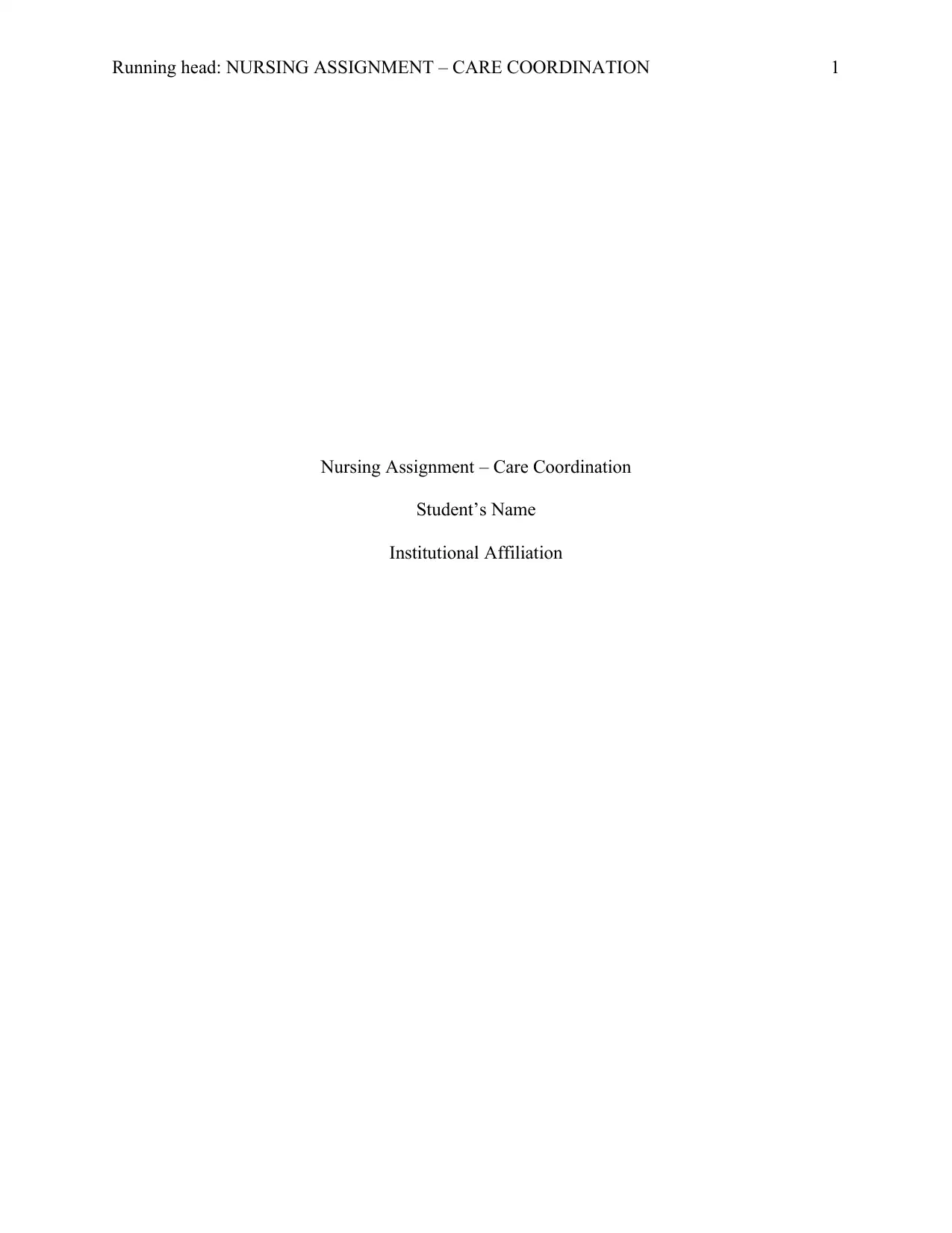
Running head: NURSING ASSIGNMENT – CARE COORDINATION 1
Nursing Assignment – Care Coordination
Student’s Name
Institutional Affiliation
Nursing Assignment – Care Coordination
Student’s Name
Institutional Affiliation
Paraphrase This Document
Need a fresh take? Get an instant paraphrase of this document with our AI Paraphraser
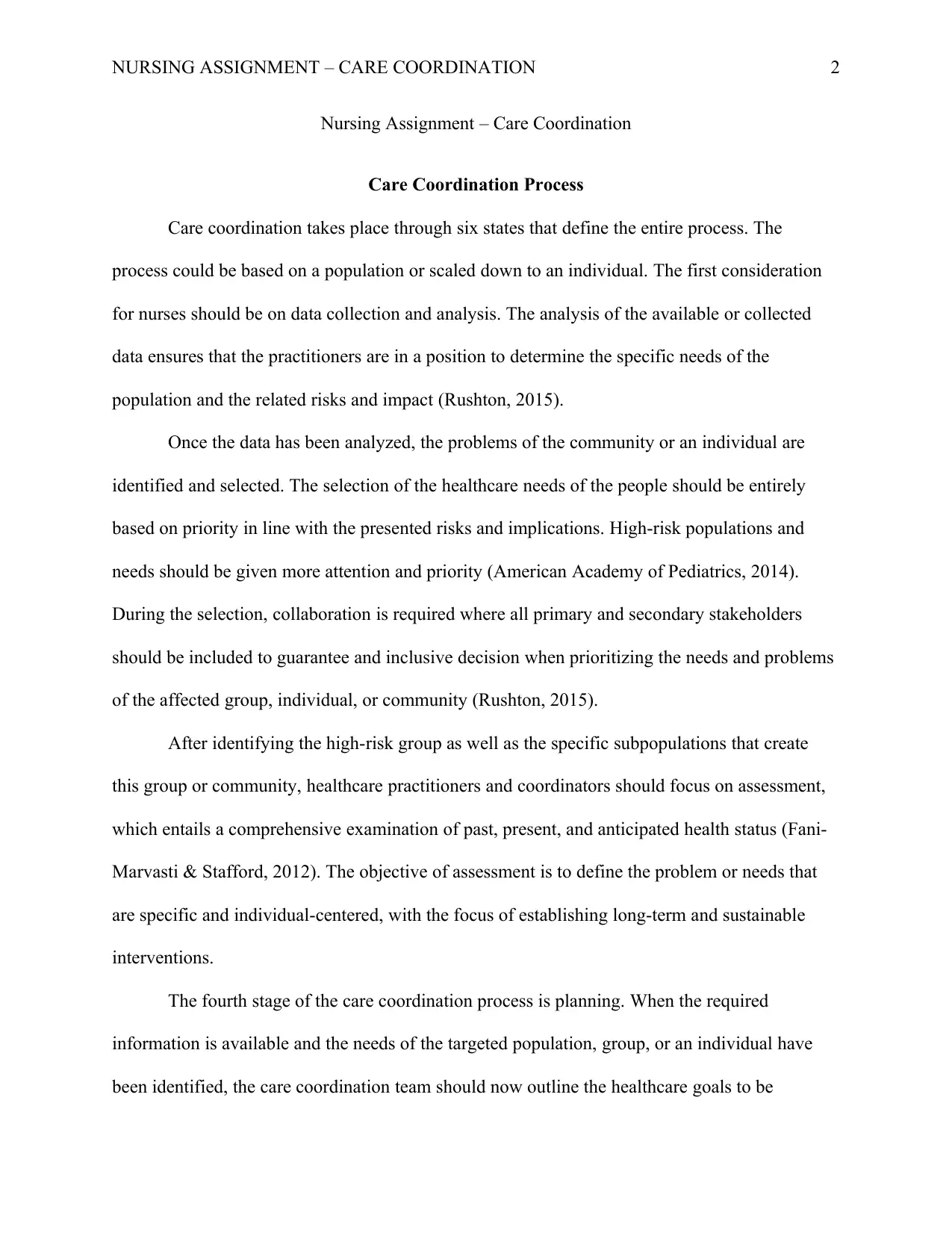
NURSING ASSIGNMENT – CARE COORDINATION 2
Nursing Assignment – Care Coordination
Care Coordination Process
Care coordination takes place through six states that define the entire process. The
process could be based on a population or scaled down to an individual. The first consideration
for nurses should be on data collection and analysis. The analysis of the available or collected
data ensures that the practitioners are in a position to determine the specific needs of the
population and the related risks and impact (Rushton, 2015).
Once the data has been analyzed, the problems of the community or an individual are
identified and selected. The selection of the healthcare needs of the people should be entirely
based on priority in line with the presented risks and implications. High-risk populations and
needs should be given more attention and priority (American Academy of Pediatrics, 2014).
During the selection, collaboration is required where all primary and secondary stakeholders
should be included to guarantee and inclusive decision when prioritizing the needs and problems
of the affected group, individual, or community (Rushton, 2015).
After identifying the high-risk group as well as the specific subpopulations that create
this group or community, healthcare practitioners and coordinators should focus on assessment,
which entails a comprehensive examination of past, present, and anticipated health status (Fani-
Marvasti & Stafford, 2012). The objective of assessment is to define the problem or needs that
are specific and individual-centered, with the focus of establishing long-term and sustainable
interventions.
The fourth stage of the care coordination process is planning. When the required
information is available and the needs of the targeted population, group, or an individual have
been identified, the care coordination team should now outline the healthcare goals to be
Nursing Assignment – Care Coordination
Care Coordination Process
Care coordination takes place through six states that define the entire process. The
process could be based on a population or scaled down to an individual. The first consideration
for nurses should be on data collection and analysis. The analysis of the available or collected
data ensures that the practitioners are in a position to determine the specific needs of the
population and the related risks and impact (Rushton, 2015).
Once the data has been analyzed, the problems of the community or an individual are
identified and selected. The selection of the healthcare needs of the people should be entirely
based on priority in line with the presented risks and implications. High-risk populations and
needs should be given more attention and priority (American Academy of Pediatrics, 2014).
During the selection, collaboration is required where all primary and secondary stakeholders
should be included to guarantee and inclusive decision when prioritizing the needs and problems
of the affected group, individual, or community (Rushton, 2015).
After identifying the high-risk group as well as the specific subpopulations that create
this group or community, healthcare practitioners and coordinators should focus on assessment,
which entails a comprehensive examination of past, present, and anticipated health status (Fani-
Marvasti & Stafford, 2012). The objective of assessment is to define the problem or needs that
are specific and individual-centered, with the focus of establishing long-term and sustainable
interventions.
The fourth stage of the care coordination process is planning. When the required
information is available and the needs of the targeted population, group, or an individual have
been identified, the care coordination team should now outline the healthcare goals to be
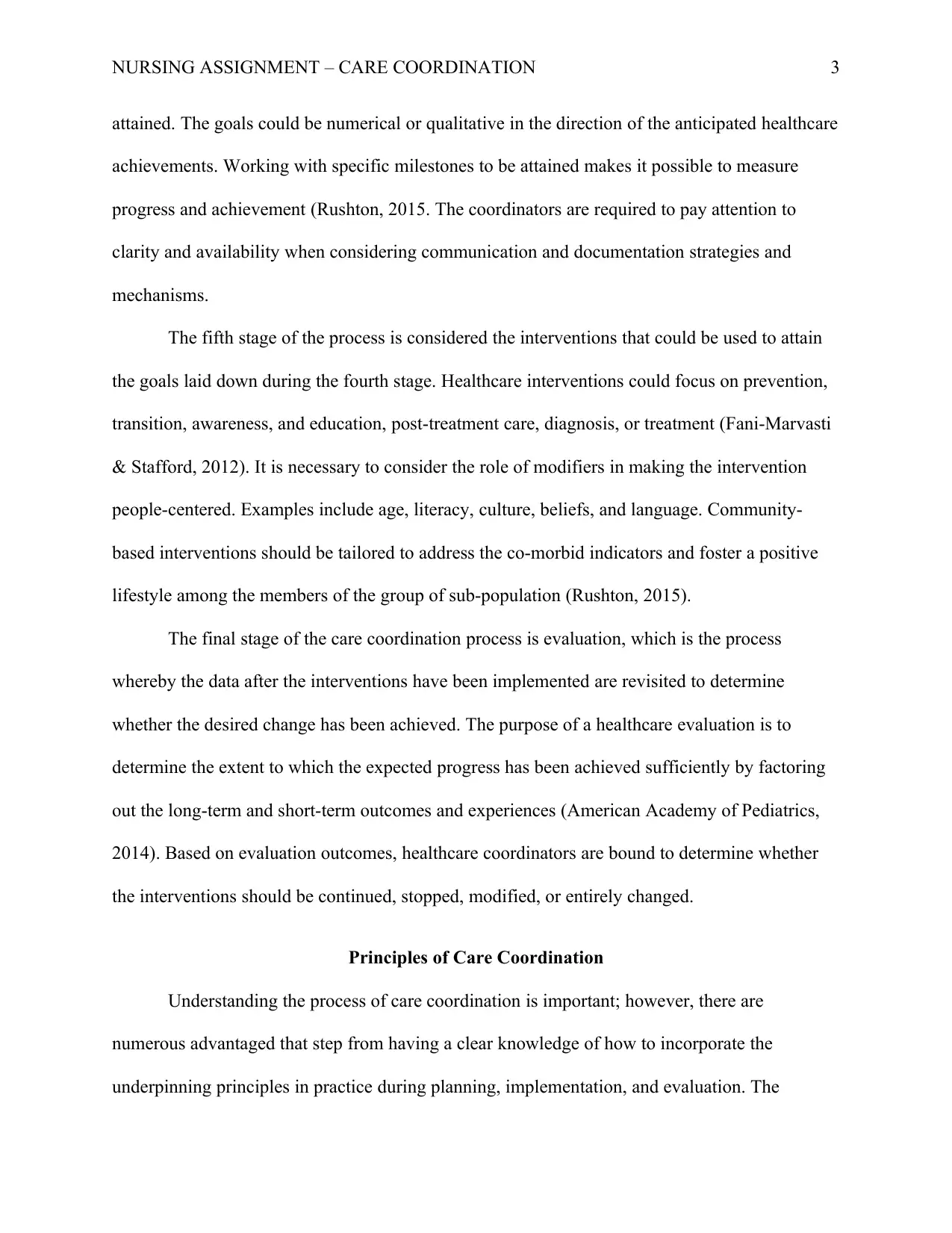
NURSING ASSIGNMENT – CARE COORDINATION 3
attained. The goals could be numerical or qualitative in the direction of the anticipated healthcare
achievements. Working with specific milestones to be attained makes it possible to measure
progress and achievement (Rushton, 2015. The coordinators are required to pay attention to
clarity and availability when considering communication and documentation strategies and
mechanisms.
The fifth stage of the process is considered the interventions that could be used to attain
the goals laid down during the fourth stage. Healthcare interventions could focus on prevention,
transition, awareness, and education, post-treatment care, diagnosis, or treatment (Fani-Marvasti
& Stafford, 2012). It is necessary to consider the role of modifiers in making the intervention
people-centered. Examples include age, literacy, culture, beliefs, and language. Community-
based interventions should be tailored to address the co-morbid indicators and foster a positive
lifestyle among the members of the group of sub-population (Rushton, 2015).
The final stage of the care coordination process is evaluation, which is the process
whereby the data after the interventions have been implemented are revisited to determine
whether the desired change has been achieved. The purpose of a healthcare evaluation is to
determine the extent to which the expected progress has been achieved sufficiently by factoring
out the long-term and short-term outcomes and experiences (American Academy of Pediatrics,
2014). Based on evaluation outcomes, healthcare coordinators are bound to determine whether
the interventions should be continued, stopped, modified, or entirely changed.
Principles of Care Coordination
Understanding the process of care coordination is important; however, there are
numerous advantaged that step from having a clear knowledge of how to incorporate the
underpinning principles in practice during planning, implementation, and evaluation. The
attained. The goals could be numerical or qualitative in the direction of the anticipated healthcare
achievements. Working with specific milestones to be attained makes it possible to measure
progress and achievement (Rushton, 2015. The coordinators are required to pay attention to
clarity and availability when considering communication and documentation strategies and
mechanisms.
The fifth stage of the process is considered the interventions that could be used to attain
the goals laid down during the fourth stage. Healthcare interventions could focus on prevention,
transition, awareness, and education, post-treatment care, diagnosis, or treatment (Fani-Marvasti
& Stafford, 2012). It is necessary to consider the role of modifiers in making the intervention
people-centered. Examples include age, literacy, culture, beliefs, and language. Community-
based interventions should be tailored to address the co-morbid indicators and foster a positive
lifestyle among the members of the group of sub-population (Rushton, 2015).
The final stage of the care coordination process is evaluation, which is the process
whereby the data after the interventions have been implemented are revisited to determine
whether the desired change has been achieved. The purpose of a healthcare evaluation is to
determine the extent to which the expected progress has been achieved sufficiently by factoring
out the long-term and short-term outcomes and experiences (American Academy of Pediatrics,
2014). Based on evaluation outcomes, healthcare coordinators are bound to determine whether
the interventions should be continued, stopped, modified, or entirely changed.
Principles of Care Coordination
Understanding the process of care coordination is important; however, there are
numerous advantaged that step from having a clear knowledge of how to incorporate the
underpinning principles in practice during planning, implementation, and evaluation. The
⊘ This is a preview!⊘
Do you want full access?
Subscribe today to unlock all pages.

Trusted by 1+ million students worldwide
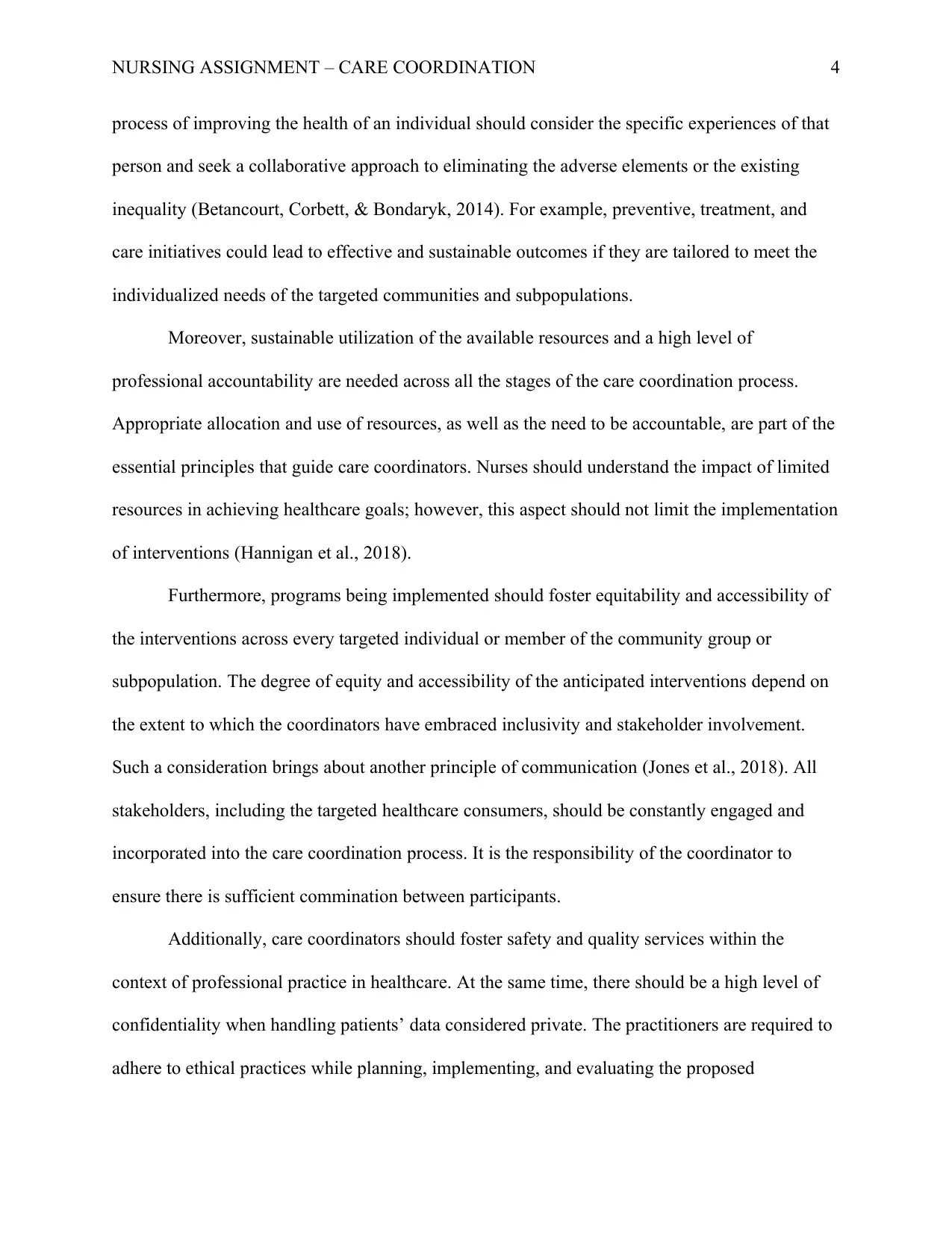
NURSING ASSIGNMENT – CARE COORDINATION 4
process of improving the health of an individual should consider the specific experiences of that
person and seek a collaborative approach to eliminating the adverse elements or the existing
inequality (Betancourt, Corbett, & Bondaryk, 2014). For example, preventive, treatment, and
care initiatives could lead to effective and sustainable outcomes if they are tailored to meet the
individualized needs of the targeted communities and subpopulations.
Moreover, sustainable utilization of the available resources and a high level of
professional accountability are needed across all the stages of the care coordination process.
Appropriate allocation and use of resources, as well as the need to be accountable, are part of the
essential principles that guide care coordinators. Nurses should understand the impact of limited
resources in achieving healthcare goals; however, this aspect should not limit the implementation
of interventions (Hannigan et al., 2018).
Furthermore, programs being implemented should foster equitability and accessibility of
the interventions across every targeted individual or member of the community group or
subpopulation. The degree of equity and accessibility of the anticipated interventions depend on
the extent to which the coordinators have embraced inclusivity and stakeholder involvement.
Such a consideration brings about another principle of communication (Jones et al., 2018). All
stakeholders, including the targeted healthcare consumers, should be constantly engaged and
incorporated into the care coordination process. It is the responsibility of the coordinator to
ensure there is sufficient commination between participants.
Additionally, care coordinators should foster safety and quality services within the
context of professional practice in healthcare. At the same time, there should be a high level of
confidentiality when handling patients’ data considered private. The practitioners are required to
adhere to ethical practices while planning, implementing, and evaluating the proposed
process of improving the health of an individual should consider the specific experiences of that
person and seek a collaborative approach to eliminating the adverse elements or the existing
inequality (Betancourt, Corbett, & Bondaryk, 2014). For example, preventive, treatment, and
care initiatives could lead to effective and sustainable outcomes if they are tailored to meet the
individualized needs of the targeted communities and subpopulations.
Moreover, sustainable utilization of the available resources and a high level of
professional accountability are needed across all the stages of the care coordination process.
Appropriate allocation and use of resources, as well as the need to be accountable, are part of the
essential principles that guide care coordinators. Nurses should understand the impact of limited
resources in achieving healthcare goals; however, this aspect should not limit the implementation
of interventions (Hannigan et al., 2018).
Furthermore, programs being implemented should foster equitability and accessibility of
the interventions across every targeted individual or member of the community group or
subpopulation. The degree of equity and accessibility of the anticipated interventions depend on
the extent to which the coordinators have embraced inclusivity and stakeholder involvement.
Such a consideration brings about another principle of communication (Jones et al., 2018). All
stakeholders, including the targeted healthcare consumers, should be constantly engaged and
incorporated into the care coordination process. It is the responsibility of the coordinator to
ensure there is sufficient commination between participants.
Additionally, care coordinators should foster safety and quality services within the
context of professional practice in healthcare. At the same time, there should be a high level of
confidentiality when handling patients’ data considered private. The practitioners are required to
adhere to ethical practices while planning, implementing, and evaluating the proposed
Paraphrase This Document
Need a fresh take? Get an instant paraphrase of this document with our AI Paraphraser
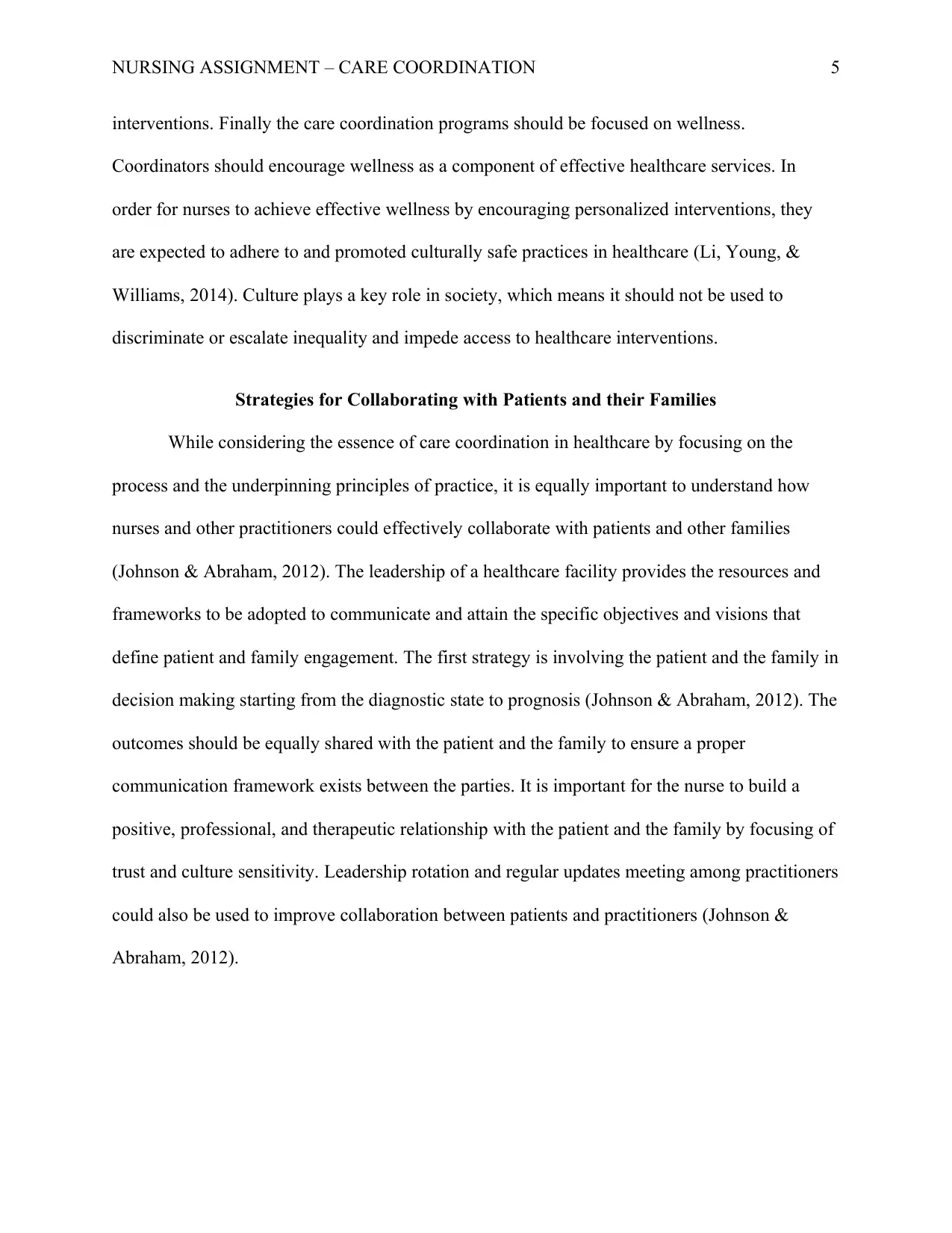
NURSING ASSIGNMENT – CARE COORDINATION 5
interventions. Finally the care coordination programs should be focused on wellness.
Coordinators should encourage wellness as a component of effective healthcare services. In
order for nurses to achieve effective wellness by encouraging personalized interventions, they
are expected to adhere to and promoted culturally safe practices in healthcare (Li, Young, &
Williams, 2014). Culture plays a key role in society, which means it should not be used to
discriminate or escalate inequality and impede access to healthcare interventions.
Strategies for Collaborating with Patients and their Families
While considering the essence of care coordination in healthcare by focusing on the
process and the underpinning principles of practice, it is equally important to understand how
nurses and other practitioners could effectively collaborate with patients and other families
(Johnson & Abraham, 2012). The leadership of a healthcare facility provides the resources and
frameworks to be adopted to communicate and attain the specific objectives and visions that
define patient and family engagement. The first strategy is involving the patient and the family in
decision making starting from the diagnostic state to prognosis (Johnson & Abraham, 2012). The
outcomes should be equally shared with the patient and the family to ensure a proper
communication framework exists between the parties. It is important for the nurse to build a
positive, professional, and therapeutic relationship with the patient and the family by focusing of
trust and culture sensitivity. Leadership rotation and regular updates meeting among practitioners
could also be used to improve collaboration between patients and practitioners (Johnson &
Abraham, 2012).
interventions. Finally the care coordination programs should be focused on wellness.
Coordinators should encourage wellness as a component of effective healthcare services. In
order for nurses to achieve effective wellness by encouraging personalized interventions, they
are expected to adhere to and promoted culturally safe practices in healthcare (Li, Young, &
Williams, 2014). Culture plays a key role in society, which means it should not be used to
discriminate or escalate inequality and impede access to healthcare interventions.
Strategies for Collaborating with Patients and their Families
While considering the essence of care coordination in healthcare by focusing on the
process and the underpinning principles of practice, it is equally important to understand how
nurses and other practitioners could effectively collaborate with patients and other families
(Johnson & Abraham, 2012). The leadership of a healthcare facility provides the resources and
frameworks to be adopted to communicate and attain the specific objectives and visions that
define patient and family engagement. The first strategy is involving the patient and the family in
decision making starting from the diagnostic state to prognosis (Johnson & Abraham, 2012). The
outcomes should be equally shared with the patient and the family to ensure a proper
communication framework exists between the parties. It is important for the nurse to build a
positive, professional, and therapeutic relationship with the patient and the family by focusing of
trust and culture sensitivity. Leadership rotation and regular updates meeting among practitioners
could also be used to improve collaboration between patients and practitioners (Johnson &
Abraham, 2012).
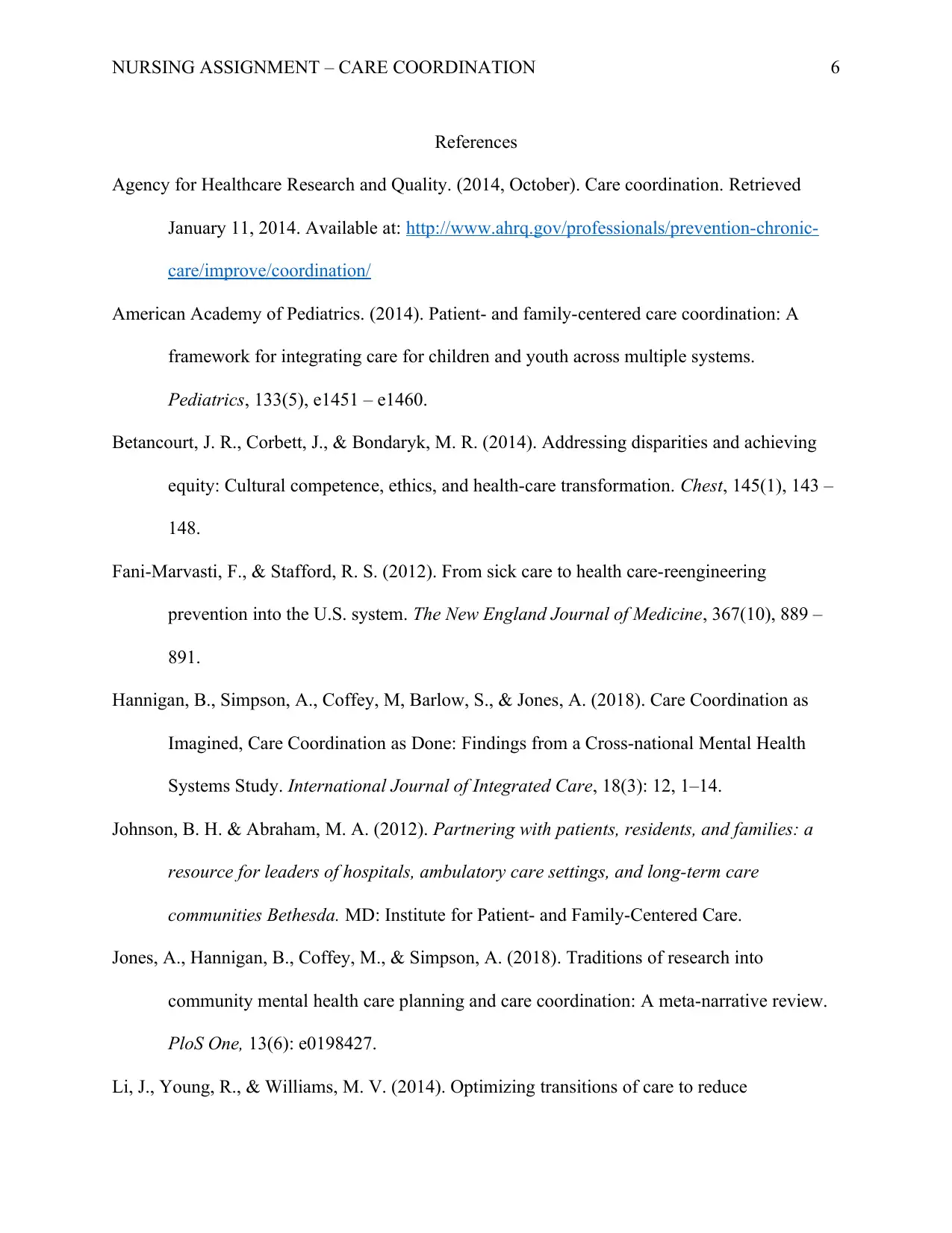
NURSING ASSIGNMENT – CARE COORDINATION 6
References
Agency for Healthcare Research and Quality. (2014, October). Care coordination. Retrieved
January 11, 2014. Available at: http://www.ahrq.gov/professionals/prevention-chronic-
care/improve/coordination/
American Academy of Pediatrics. (2014). Patient- and family-centered care coordination: A
framework for integrating care for children and youth across multiple systems.
Pediatrics, 133(5), e1451 – e1460.
Betancourt, J. R., Corbett, J., & Bondaryk, M. R. (2014). Addressing disparities and achieving
equity: Cultural competence, ethics, and health-care transformation. Chest, 145(1), 143 –
148.
Fani-Marvasti, F., & Stafford, R. S. (2012). From sick care to health care-reengineering
prevention into the U.S. system. The New England Journal of Medicine, 367(10), 889 –
891.
Hannigan, B., Simpson, A., Coffey, M, Barlow, S., & Jones, A. (2018). Care Coordination as
Imagined, Care Coordination as Done: Findings from a Cross-national Mental Health
Systems Study. International Journal of Integrated Care, 18(3): 12, 1–14.
Johnson, B. H. & Abraham, M. A. (2012). Partnering with patients, residents, and families: a
resource for leaders of hospitals, ambulatory care settings, and long-term care
communities Bethesda. MD: Institute for Patient- and Family-Centered Care.
Jones, A., Hannigan, B., Coffey, M., & Simpson, A. (2018). Traditions of research into
community mental health care planning and care coordination: A meta-narrative review.
PloS One, 13(6): e0198427.
Li, J., Young, R., & Williams, M. V. (2014). Optimizing transitions of care to reduce
References
Agency for Healthcare Research and Quality. (2014, October). Care coordination. Retrieved
January 11, 2014. Available at: http://www.ahrq.gov/professionals/prevention-chronic-
care/improve/coordination/
American Academy of Pediatrics. (2014). Patient- and family-centered care coordination: A
framework for integrating care for children and youth across multiple systems.
Pediatrics, 133(5), e1451 – e1460.
Betancourt, J. R., Corbett, J., & Bondaryk, M. R. (2014). Addressing disparities and achieving
equity: Cultural competence, ethics, and health-care transformation. Chest, 145(1), 143 –
148.
Fani-Marvasti, F., & Stafford, R. S. (2012). From sick care to health care-reengineering
prevention into the U.S. system. The New England Journal of Medicine, 367(10), 889 –
891.
Hannigan, B., Simpson, A., Coffey, M, Barlow, S., & Jones, A. (2018). Care Coordination as
Imagined, Care Coordination as Done: Findings from a Cross-national Mental Health
Systems Study. International Journal of Integrated Care, 18(3): 12, 1–14.
Johnson, B. H. & Abraham, M. A. (2012). Partnering with patients, residents, and families: a
resource for leaders of hospitals, ambulatory care settings, and long-term care
communities Bethesda. MD: Institute for Patient- and Family-Centered Care.
Jones, A., Hannigan, B., Coffey, M., & Simpson, A. (2018). Traditions of research into
community mental health care planning and care coordination: A meta-narrative review.
PloS One, 13(6): e0198427.
Li, J., Young, R., & Williams, M. V. (2014). Optimizing transitions of care to reduce
⊘ This is a preview!⊘
Do you want full access?
Subscribe today to unlock all pages.

Trusted by 1+ million students worldwide
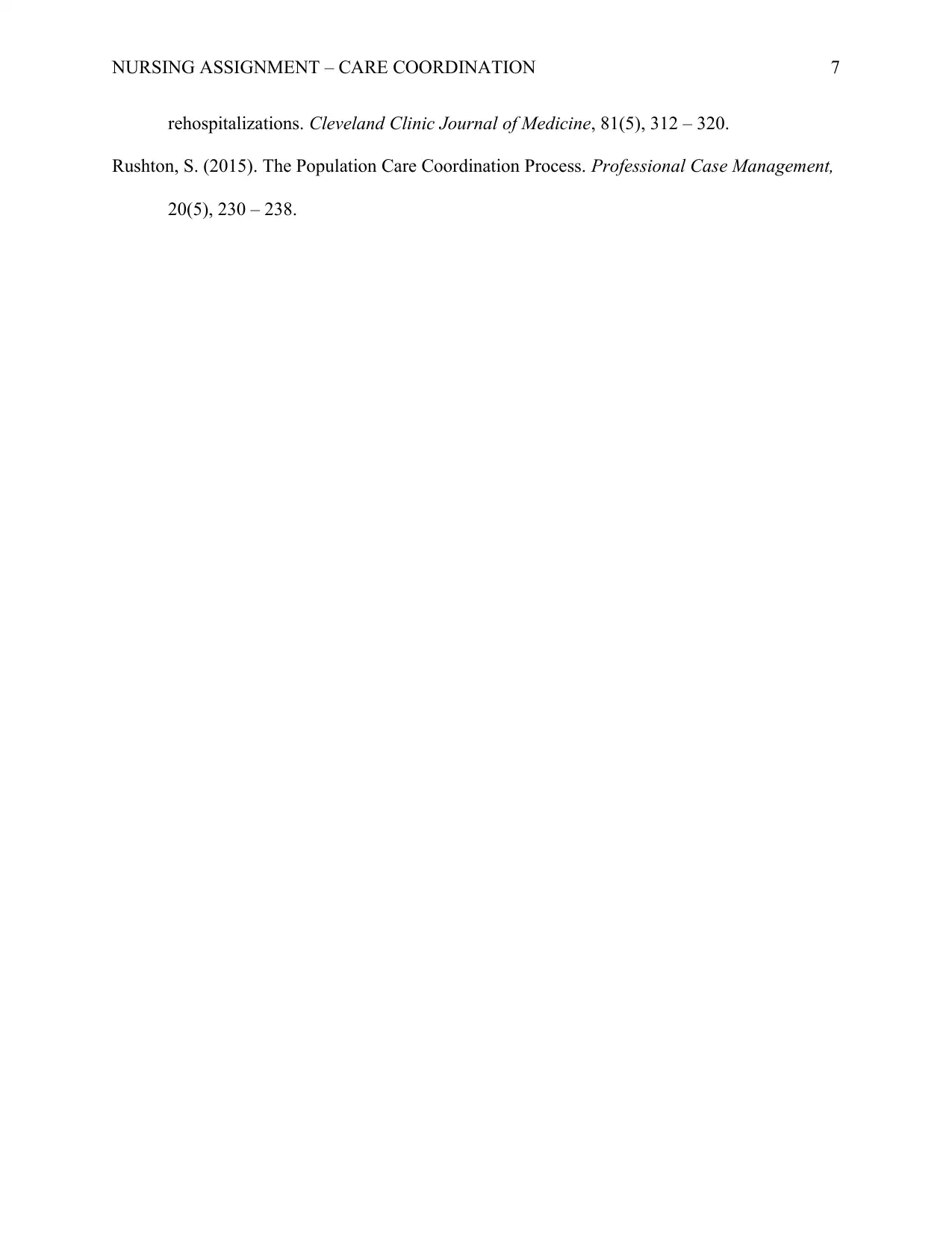
NURSING ASSIGNMENT – CARE COORDINATION 7
rehospitalizations. Cleveland Clinic Journal of Medicine, 81(5), 312 – 320.
Rushton, S. (2015). The Population Care Coordination Process. Professional Case Management,
20(5), 230 – 238.
rehospitalizations. Cleveland Clinic Journal of Medicine, 81(5), 312 – 320.
Rushton, S. (2015). The Population Care Coordination Process. Professional Case Management,
20(5), 230 – 238.
1 out of 7
Related Documents
Your All-in-One AI-Powered Toolkit for Academic Success.
+13062052269
info@desklib.com
Available 24*7 on WhatsApp / Email
![[object Object]](/_next/static/media/star-bottom.7253800d.svg)
Unlock your academic potential
Copyright © 2020–2025 A2Z Services. All Rights Reserved. Developed and managed by ZUCOL.





